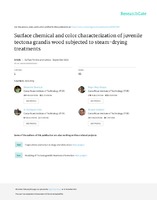Surface chemical and color characterization of juvenile tectona grandis wood subjected to steam-drying treatments

Date
2016Author
Rodriguez-Solís, María
Berrocal-Jiménez, Alexander
Starbird-Pérez, Ricardo
Muñoz-Acosta, Freddy
Moya-Roque, Róger
Metadata
Show full item recordAbstract
The color of Tectona grandis wood is an attribute that favors its commercialization, however, wood
color from fast-growth plantation trees is clear and lacks uniformity. The aim of this work is to
characterize steamed teak wood by means of the Fourier transform infrared spectroscopy (FTIR)
and L a b color systems. Two moisture conditions (green and 50%) and two grain patterns (°at
and quarter) of boards were analyzed through the application of di®erent steaming times (0, 3, 6, 9,
12, 15 and 18 h). The FTIR results showed that the bands at 1158, 1231, 1373 and 1419 cm 1 did not
show any change with steaming, whereas the bands at 1053, 1108, 1453, 1506, 1536, 1558, 1595,
1652, 1683, 1700 and 1733 cm 1 presented a decrease in the intensity with the steaming time. The
band at 1318 cm 1 was the only one that increased. Lightness (L ) was the most a®ected parameter,
followed by yellowness (b ), while redness (a ) showed the smallest change. Surface color change
( E ) presented the lowest value between 3 h and 6 h of steam-drying in the boards with °at grain,
whereas for boards with quarter grain, the smallest E value was obtained after 18 h of steaming.
Description
Artículo
Source
Surface Review and LettersShare
Metrics
Collections
- Artículos [37]

